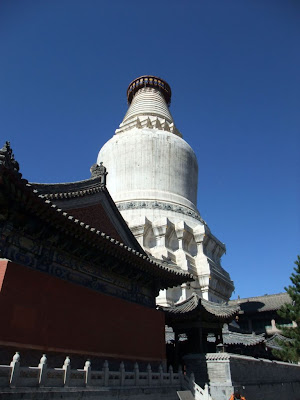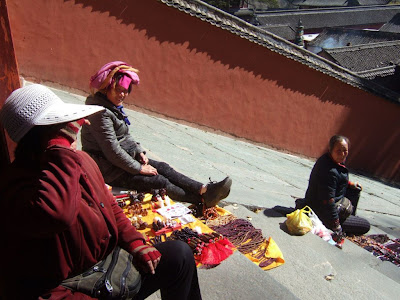
The 50 meters high Great White Pagoda (大白塔) from Temple Tayuan-si (塔院寺) was the most symbolic sight in Wutaishan. It was untraceable when it was first established but basing on Qingliang-shan Annal, it had been existing in Han Dynasty (206BC-220AD). The Pagoda was already there when the Indian monk Rev. Dharmavanya (Motong) visited Wutaishan on his trip to Luoyang to build the first Buddhist Temple Baima-si under the request of Han Emperor Hanming-Di (汉明帝 58-76 BC). It was believed that The Pagoda which was named as Cishou-Ta (慈寿塔) at that time, was one of the 19 Stupa in China that enshrined a Buddha Bone Relic. The present Great White Pagoda according to professional research, was constructed in year 1302 during Yuan Dynasty (1271-1368) with design from a Nepalese artisan. It was a great project and tough task as the original Cishou-ta was to be placed inside the new Pagoda. The Pagoda when completed, was actually part of Xiantong-si Monastery. It only split out and became an independent temple site 105 years later under an imperial order of Emperor Zhudi (朱棣帝) in year 1407 during Ming Dynasty. In year 1579, the temple site was once again restored and expanded with an order given by Empress Li. The latest renovation was done in 1952 with financial support from Central Government.



The Pagoda appearing something like a vase or a bottle from the outlook was built in a Tibetan Lama Style. The body structure was built with brick slabs with a Octagon stone base and a cylindrical seasoned bronze made shrine top. The Pagoda completely covered with a creamy white paint, was adorned with delicate decorations and many fine copper accessories.



The top of the 13 layers wheel-like construction were covered with 8 pieces of bronze plates forming a round saucer of about 23 meters in circumference. The bronze plates were installed in accordance to Fengshui position. There are 36 pieces bronze drooping accessories at the edges of the eaves, each hanging with 3 tinkling bronze bells, totaling to a number of 252 units together with those hanged at the middle sunken part of the pagoda. The exotically eerie sounds are echoing in the air of Town Taihuai-zhen whenever wind blows, delighting and soothing.



The full name of Great White Pagoda reads as Sakyamuni Relic Pagoda or cut short, as Relic Pagoda. Sometimes, it was also known as The Great Compassion Life Lengthening Pagoda (Daci-Yanshou-Ta 大慈延寿塔). It is the symbol and prominent landmark of Wutaishan.



There are three shallow dug-out portion at the South end of the Pagoda. A stone engraved with two Buddha's food prints was placed at one of them. The foot print measured as 1.6 feet long x 6" wide were believed to be traced from the originals. It was said that Buddha Sakyamuni before entering into Nivana, left his foot print on a mountain rock and told his disciples that whoever made offering or paid respect to it, would quell off disasters. Master Xuanzang (玄奘法师) when traveled to India, made a copy of it and brought back to China. Under an imperial order of Emperor Tang-Taizong (唐太宗 599-649), the foot prints were then engraved on the stone and kept in Temples. The foot carving here was based on a duplicate copy that brought in and offered to Wutaishan by a monk named Gezu (鬲羽 祖) from Shaolin-si in Ming Dynasty.



Another dug-out hollow enshrined with Images of Buddha and Dharma Protector Bodhisattva Weituo (韦陀菩萨) who was expected to protect the Pagoda from damages.

.jpg)
The ground base of Great Pagoda is surrounded by long veranda installed with 123 units of 8 cm tall bronze made cylindrical prayer mills, engraved with six Tibetan characters 唵。嘛。呢。叭。咪。口牛。read as Om Ma Ni Pa Mi Hum. It was said that whoever carry with this powerful Guanyin Mantra in body, touch it with hand or keep it at home, would always be safe and free from disasters and misfortunes.



Turning round the prayer mills to avert evils and be smooth and fine in life.



The big prayer Mill in the pavilions at the four corners of the Veranda at Pagoda Base is as high as 1.8 meter. Though it is comparatively huge, it has no difficulty to easily twirling once it was pushed by hand.




Another famous structure at the temple site, is its two storey Library Hall where there was a huge hexagonal revolving wooden bookcase rising through its two floors. The innovative product was created and done by a great Buddhist Master Hanshan (憨山) in year 1572 during the reign of Emperor Wangli in Ming Dynasty. It was designed and built into 21 layers with small partitions to hold more than 20k volumes of Buddhist Scriptures in languages of Chinese, Mongolian and Tibetan. It was believed that to turn the bookcase round one time was equivalent to one recitation of Sutra. It represented sign of turning the Dharma Wheel at all times. Presently, the revolving base was not able to work anymore but the numbers of Dharma books and Sutra at the Library remain, in order and system.

.jpg)

The four Chinese characters on the red plague (金栗来仪) at The Library Hall was a hand written compliment phrase from Emperor Kangxi (1662-1722) and the 7-phrased poem on the wooden tablet was written by his grandson Emperor Qiang-Long (1736-1796) during his 6th visit to Wutaishan. He wrote down his true emotion when found that the Hair Stupa had been burnt down by fire three years ago. The Shrine Hall presently enshrines ten images of Buddha and 8 images of Bodhisattva with Buddha Verocana (毗卢遮那佛) at frontal position followed by Amitaba, Medicine Buddha, the past 7 Buddha (毗户尸佛,尸弃佛,毗舍那佛,拘留孙佛,拘那那舍佛,迦叶佛和释迦摩尼佛) and 8 Maha Bodhisattva. To house so many Buddha images inside a hall in fact is not too common in any temple site.


The Great Compassion Life Lengthening Hall enshrines Images of The three Huayuan Sages: Buddha Verocana (毗卢遮那佛) with Bodhisattva Manjushri and Samantabhadra to his left and right, and Arahant Ananda and Mahakasyapa in front. The two Tibetan worship Bodhisattva Green and White Tara are by the side of Puxian and there are two images of Amitaba at the sides of Manjushri. There are five colored Manjushri in Wutaishan. Compared to Images of Manjushri in Temple Pusa-Ding (yellow), Luohou-si (white), Xiangtong-si (green) and Shuxiang-si (blue), the image of Manjushri here with black beard looks masculine. Inside the Hall, there are also 18 Arahant sculptures by two walls with wooden tablets hanging on the wall, inscribed with handwritten notes or phrases from Emperor Kangxi, Qianlong and Jiaqing.



The Hall Daci-Yanshou-Dian (大慈延寿殿) originally was the Grand Shrine Hall. The name was so called was to wish longevity for the compassionate Empress Li who highly respected Buddhism and had faith in the religion thus greatly influenced her son Emperor Wanli (1563-1620) to highly honor all Sangha, to frequently restore and build temples. Buddhism reached its glory peak during his 40 over years of reign. In view of her great merits with virtue, people named the Grand Shrine Hall as The Great Compassion Life Lengthening Hall.



The elegant Manjushri Hair Stupa is a precisely built mini size Stupa erected at the east corner of the Great White Pagoda. It was said that sealed inside the small pagoda are strands of Manjushri's golden hair which was left down by The Bodhisattva when he made his earthly appearance. The Legend said that in order to emphasize the equality for all living beings, Manjushri once manifested into a poor woman and begging for food in the Grand Food Offering Ceremony organized every year in Spring by old Temple Xiantong-si. The monk in-charge was not too polite as the slovenly dressed woman after having four bowls of porridge for herself, her two kids and her dog, further requesting for her baby in her stomach. While the monk began to raise up his voice in temper, the woman suddenly rose up to the sky and transformed back to the true original form of manjushri. He uttered few Buddhist Hymms highlighting the equality of living beings. The monk in-charge with much regret for judging people from appearance and not able to recognize the sage in time, intended to maim his own eyes but under the advices of other monks and also appreciated for given the opportunity to encounter the true form of Bodhisattva, listen to his teachings, he finally decided to build a stupa to keep Manjushri's golden hair for worshiping.
.jpg)
.jpg)

Lokapala Hall is the first hall to enter into Tayuan-si. The tablet below the roof eaves was written with "Built Under Imperial Order Nation Blessed Great Pagoda Monastery" (敕建护国大塔院寺). It has three doors but closed, only a side door is opened for entry. The frontal place of Hall instead of housing the statue of Bodhisattva Matreya, it enshrines an Image of Guanyin with a stone stele erected behind. The Stele built in March 1577 in Ming dynasty was engraved with a digest decree of law from Emperor Wanli addressed to the Abbot and Sangha of the Monastery at the time when The Empress printed and distributed the Sutra to the Temple. The ordinance stated that the teachings of Buddha were all in the Sutra, that guided people to do good wholesome deeds, to clear one's confusion and blindness and make people conscious and aware of their own failings. It was an order to read, to worship and to value the Sutra seriously and respectfully. To profane, damage or lost the Sutra were strictly prohibited. Emperor Wanli reigning from 1563-1620 was a great Dharma protector in China Buddhism history.



The Drum Hall.


The Great White Pagoda always is a beautiful sight when viewing from other Temples site.



An old Tibetan monk under the warm sun, mindfully twirl the prayer wheels.


The happy contented Tibetan villagers selling Buddhist souvenir along the stairway at Dayuan-si.


A distance view of White Pagoda looks pleasing yet magnificent.


The Great White Pagoda is situated at the center of Taihuai-Zhen, winded up by many temple structures.


.jpg)
It is indeed the symbol of Wutaishan.


The Three Pagoda Temple Santa-si (三塔寺) located nearby The White Pagoda, was reputed with its three ancient pagoda. It was originally built by a Zen Master Rev. Liaoceng (了尘大师) in Ming Dynasty during the reign of Emperor Wanli. The three magnificent old Pagoda were built under an imperial order after the frequent visits of those emperors and empresses. Empress Li also had several times come to pay homage to it. It was said that the Relic of Bodhisattva Manjushri was placed in the center pagoda and Relic of Guanyin and Puxian were placed in the other two pagoda. The culture of Tibetan Buddhism began to penetrate into Santa-si after Lama Master Gong-Ga (贡嘎上师) of Pusa-Ding, who came from Lingbo, took it as self-cultivation and meditation center. The Three Pagoda Temple was renovated and converted into Tibetan Yellow Sect Buddhism in Qing Dynasty, and was highly honored by Emperor Kangxi and Qianlong. (We did not went up into the site as it was under renovation).


A mini sized Tibetan Village along the way to Santa-si.


The Great White Pagoda and the oldest temple Xiantong-si is within walking distance. We were ready to tour The pioneer temple site of Wutaishan, Xiantong-si. The seeds and nuts selling by the side of Xiantong-si are wild grown products of Wutaishan.


No comments:
Post a Comment